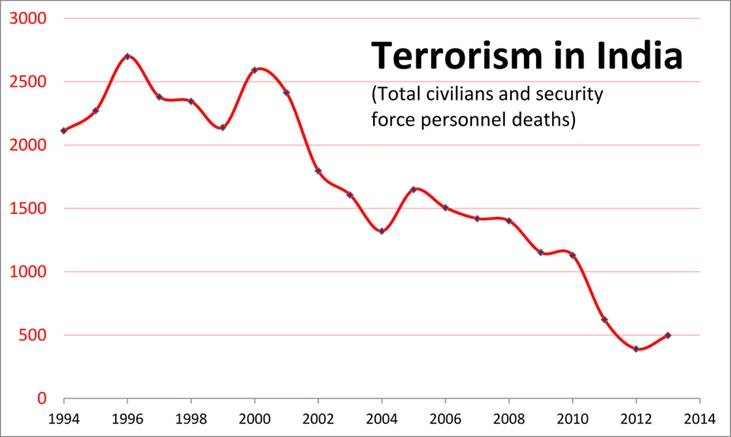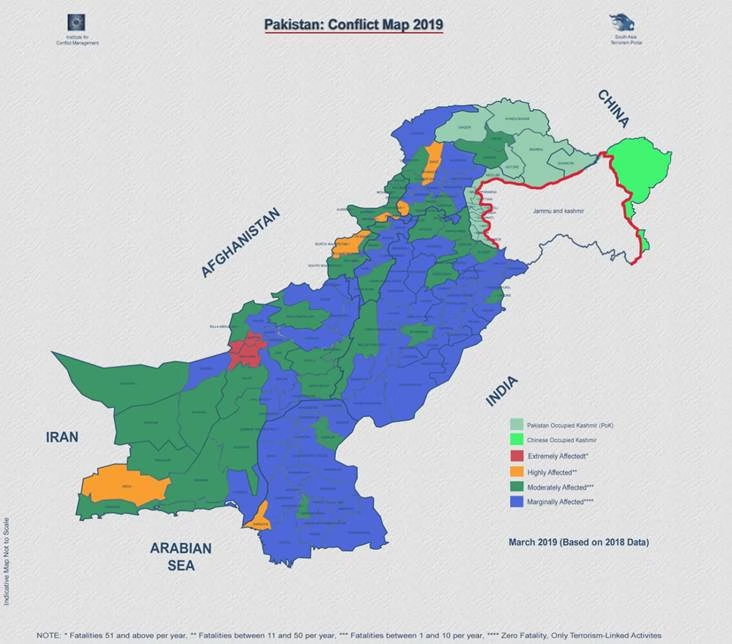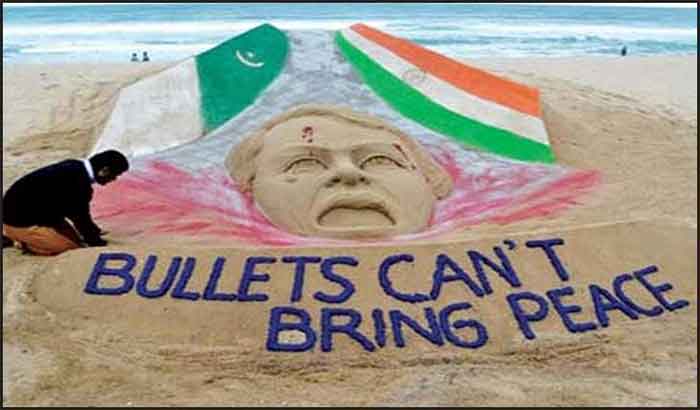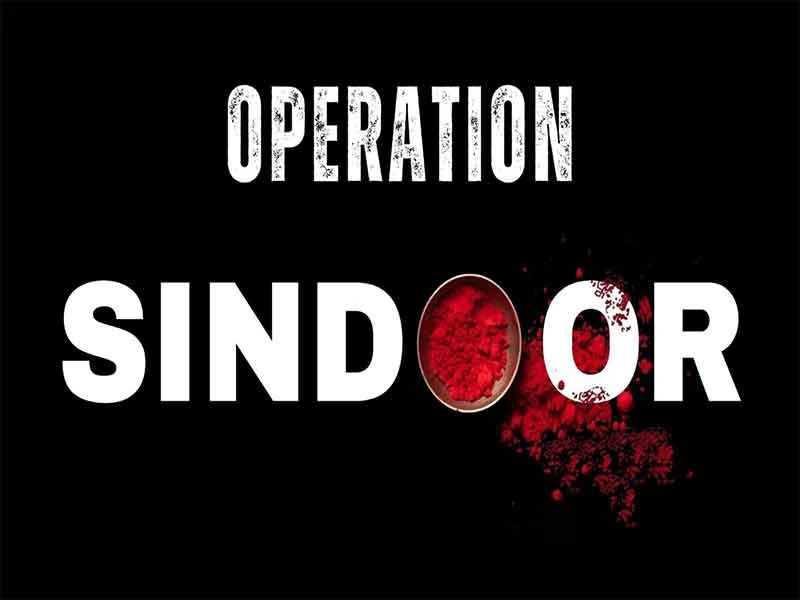
Now that India carried out, since the intervening night of May 6-7, Operation Sindoor, and avenged the Pahalgam attack of April 22 by terrorists, sanity demands the path of peaceful dialog is pressed for by all concerned.
This article, in two parts, seeks to review and discuss some aspects related to the current sensitive situation, in the wake of Pahalgam incidents, and its aftermath of war-like situation. Hopefully, Operation Sindoor would be a limited exercise. It intends, among other things, to dispel anti-Muslim frenzy, a global phenomenon, being whipped up in India by Hindutva forces, also with vote-bank politics in full play.
In particular, it brings out some facts about terrorism in South Asia, with a view to clarify matters, and put things in perspective: Various facts and official data, as also the map given above, show that it is not as if India is a lone victim and Pakistan is a lone offender. This article, among other things, analyses some data publicly available online, provided by SATP, an authentic source, launched in March, 2000, related to terrorism in South Asia (more about SATP later.)
Will Op Sindoor put an end to terrorism, particularly in relation to Kashmir? Will a dialog take place soon and ease the situation? Experience is telling:
Indian ruling classes, more so BJP and Modi, claimed to be a “democratic ally” of US imperialists, also in its “Global war on Terrorism” that was launched by USA in 2001, post Sep11 WTC incidents, to “exterminate” Islamic terrorism. Almost a quarter century later, and after a few million civilian Muslims were killed by US and its allies, there are more number of terrorist groups and unabated incidents.
Trump-led USA arrived at a Oman-mediated truce with Yemen’s Houthis (May7), around the same time as Op Sindoor. Trump surprisingly praised them for “their bravery,” in facing up to the heavy US bombing, and said US stops bombing with immediate effect. Houthis confirmed the deal, they paused attacks on shipping in the Red sea, and said: It has “no connection with our stance on supporting Gaza”. Israeli agencies said they were ditched by Trump.
South Asia, fortunately, had its last full-fledged war 50 years ago (Bangladesh,1971).That war, among other things, exploded the myth of two-nation theory that created India and Pakistan. Islam could not stop dismemberment of Pakistan, nor the current turmoil in Bangladesh. Nor could it stop almost a decade-long war (1980-88) between Iran and Iraq. But still there are forces all around spreading misinformation about ‘threat from Islamic forces’.
If the more affluent Midle East (GDP per capita $12,850) has more of wars for decades, the poorer South Asia (GDP per capita $2,650) has more of terrorism, though both war and terrorism are two forms of conflicts, real or fomented. MIC presumably knows the limits of their markets.
*** ***
“Now is the time for maximum restraint and stepping back from the brink. Make no mistake: a military solution is no solution.”: UN Chief

UN Secretary-General Antonio Guterres delivers a speech during a UN Security Council meeting at the UN headquarters in New York City on April 29, 2025. (AFP/File). Indian media presented as if India is getting wide and unqualified support. But the key word is “restraint” that is advised by one and all.
Guterres told reporters in New York that Pakistan-India relations had reached “a boiling point,” while condemning the April 22 attack and calling for those responsible to be brought to justice through “credible and lawful means.” “It is also essential, especially at this critical hour, to avoid a military confrontation that could easily spin out of control,” he said.
Pakistan has denied any involvement and called for a credible, neutral, international probe into it as international pressure continues to pile on both New Delhi and Islamabad to de-escalate.
Aboard Air Force one, on April 25, President Trump remarked “They’ll get it figured out one way or the other.” “There’s great tension between Pakistan and India, but there always has been.”
U.S. Secretary of State Marco Rubio did speak to Indian and Pakistani decision- makers on April 30, again primarily to urge restraint.
US National Security Advisor John Bolton reportedly amplified US support for “India’s right to self-defense against cross-border terrorism” during a conversation with his Indian counterpart. India could have reasonably perceived this as tacit US support for Indian military action. Indeed, this seems to have been the U.S. intent: to accept India’s need to let off steam and press Pakistan to hold back in response.”
This is precisely how India wanted the crisis to end as well, though the dynamics of war are unpredictable.
Said a commentator:
“ Third party backing was still a necessary ingredient for India’s success. Minus third party pressure to force an end to the crisis, India (or Pakistan) has no credible means of preventing an all-out war that could end in a catastrophe…
“Recurring India-Pakistan crises, let alone war, also directly undermine U.S. interests in South Asia since they will keep India bogged down and distracted from America’s larger objective of using India as a counterweight to China.”
Separately, the OIC Group in New York, expressed its “deep concern” over the situation in South Asia. Representing 57 Islamic countries, including Saudi Arabia and the Gulf Emitates, also wooed by Modi, the OIC Group in a statement, reiterated its principled position against, and condemnation of terrorism in all its forms and manifestations, committed by whomsoever and wherever; and reaffirms its unequivocal rejection of all attempts to associate any country, race, religion, culture or nationality with terrorism,” it said “The Group commends the offer of good offices made by the UN Secretary General and calls upon the international community, including the United Nations Security Council and influential states, to take immediate and credible measures to de-escalate the situation.”
*** ***
“This is not the age of war” : Modi
In this context, when Pakistan admitted to terrorism and “our govt then made a mistake,” it is apt to recall PM Modi’s words:
Major powers USA, Russia and China, not to speak of UNO and OIC, urged for restraint on the part of India and Pakistan, both nuclear powers. The whole world, including Pakistan, waits to see if PM Modi defies the hawks in the Indian Establishment and walks the talk he had made repeatedly. The same is expected of Pakistan too. It is apt to recall, at this critical juncture, PM Modi’s repeated appeals and pledge for dialog and peace:
“Calling for concerted action against terrorism, PM Modi had said the menace poses a serious challenge to global peace and security. To combat it, forces that believe in humanity must come together and work in tandem. He said that while addressing the East Asia Summit last October: “I come from the land of Buddha, and I have repeatedly said this is not the age of war. It’s essential to respect sovereignty, territorial integrity and international laws..solutions cannot be found in battlefields.. India, in fulfilling its responsibilities as a “vishwabandhu”, would continue to make every effort to contribute to peace efforts”. (Times of India, Oct 12, 2024.).
Times of India, an Establishment voice, in an editorial of May 6 noted:
“India’s news television, to no one’s surprise, is in battle cry mode. But India’s govt, doubtless looking at the big picture in all its dimensions, should appear to go about its business in stark contrast to the frenzy on the small screen…India, unlike Pakistan, has a future to consider. ..News television anchors and social media warriors may want ‘action’ now. GOI should, as it is already doing, concentrate on acting wisely”.
In the wake of hawkish calls and claims, from within and outside of official quarters, for ‘taking back’ what India calls “PoK”, PM Modi’s words “respect sovereignty, territorial integrity and international laws”, assume all importance. Right now, Balochistan and PoK are turbulent, more than ever, with both internal and external forces in full steam. Dialog, not war, is the need of the hour now. That is the ACTION now needed. Platitudes won’t do.
The whole world, including Pakistan, waits to see if PM Modi leads or defies the hawks in Indian Establishment and walks the talk.
*** ***
Class and political aspects of Pahalgam
Several migrant workers (around 28) were killed by terrorists in Kashmir in recent past, after Omar Abdullah formed a govt in October last, reported New Indian Express, Nov 2, 2024: “ This is the fifth targeted attack on migrant workers in the valley”. Why killing migrant workers was not big news, like Pahalgam attack on tourists, for the media, or the authorities? After all, they do not give big TRP ratings.
Senior political analyst Swapan Dasgupta, a Rajya Sabha Member of BJP until recently, wrote a comment, Why Pahalgam response poses a challenge, just 2-3 days before the Op Sindoor. The victims “were all middle class…their collective call for justice and retribution is a force-multiplier the BJP can not ignore.” It is a “challenge before PM Modi to give a fitting reply, without at the same time being drawn into a larger regional conflict.” (Revenge, badla are notorious, but lucrative, themes of our costly films; now freely used in war times too. Yes, they want retribution too. After all India spends around Rs.7 lakh cr annually on Defence Budget. A part of it may be spent for “retribution” too! BJP can not ignore, the journalist-writer frankly said, and commented on the media role:
“Unfortunately the popular mood – fueled by media sabre-rattling– is one of rising impatience. If this is allowed to persist, there will be backlash..” (also from the Opposition which may project the PM as “a paper tiger”).
”For its political sustenance, it must be remembered, the BJP depends on Hindu consolidation.” He refers to turmoil, post-Waqf act, and concludes: “Unless middle class India feels its anger has been addressed by effective action, the govt could become busy quelling fires on the home front.” (Times of India, May 4, 2025).
We should thank Swapan for his brutally frank observations on class and political factors of Pahalgam. He had earlier the Hindutva interests in relation to Bangladesh turmoil.
See “ Hindutva Sought To Be Injected Into India’s Foreign Policy For Hegemony Over Bangladesh, Countercurrents.org, 03-01-2025.
Now we go to the business part of it.
*** ***
MIC, Israel and Adanis: “combat debut in South Asia”
Who benefits by wars and terrorism? The Military Industrial Complex (MIC), USA leading the pack of merchants of death. Even India led by Modi hopes to push up its GDP, and set a target of military exports worth Rs. one lakh crore.
(See: India’s Shift to Defence-oriented Economy, with increasing role for the private sector. Countercurrents.org, 19-03-2023.)
A recent report (March 18,2025), citing SIPRI, said:
India, Qatar, Saudi, Pakistan are four biggest arms importers globally, between 2000-2024, next only to Ukraine. Middle East accounted for 33% of all imports. But that doesn’t include Palestine or Gaza, that faced war! It also found that the five largest arms exporters in 2020–24 were the United States, France, Russia, China and Germany. Israel, busy fighting Gaza war, has been exporting arms but not listed here. In 2023, its military exports were worth $ 13 billion, Air defence (AD) systems alone make up 36% of those exports.
In the current operation, two important weapon systems, both unmanned, supplied by Israel played a decisive role, it is reported: “SkyStriker suicide drones”, made in Bangalore by a JV with Elbit Security Systems is one: it “flies like an unmanned aircraft, and strikes like a missile.” The other is “Harop And Harpy Suicide, or Kamikaze Drones.” The media is full of their efficacy as killing machines, but Israel is not much mentioned. The other of course is Russian-suplied S-400, SAM system, projected as India’s Sudarshan Chakra (of Hindu mythology): “ 3 squads of S-400s were deployed under Rs 40,000 cr deal in Oct 2018.” (Times of India May 8 and 9).
Thus India provided an opportunity to test the Israeli “loitering munitions” on the ground. They made “spectacular combat debut in South Asia by crippling Pak’s AD systems. ” (Eurasian Times, May 8,2025) . At the time they were shown in an Airshow in 2009, ten drones cost $ 100 million; ADTL (Alpha Design Technologies Ltd) of Adanis, roped in 2022-23, is one of the main joint venture partners of Israel in India.
MIC of India has been open to FDI too; Tatas and Ambanis are among major private sector partners, of course ever since Congress rule, which opened, (like Ayodhya gates), the defence gates to private sector.
PM Modi continued and advanced that policy; he is their best sales manager, ostensibly pushing up India’s GDP: Check all recent foreign tours of Modi: Defence (production and trade) co-operation is invariably an important item. That includes with Islamic states like Saudi Arabia, UAE and Bahrain.
Pakistan’s Terrorists “used as proxies by the USA,” says its Defence Minister
Pakistan too has its own MIC, and even arms exports, though smaller. One Pak top spokesman said recently, Pakistan is the most reliable and efficient Frontline state in the “Global war against Terrorism”. He said Trump-1.0 had appreciated Pak’s role, and claimed 90,000 Pak soldiers (martyrs!) died fighting terrorism; they are the cannon-fodder in the name of Islam. Observers recalled there was no full-fledged war in South Asia for 50 years. So terrorism is sustained by MIC. Everyone loves drought, wrote P.Sainath, decades ago, saying it is most lucrative to ruling classes. Now someone should write, “Everyone loves terrorism.” it is not only lucrative, but “heroic” too. Crusades, jihads and dharma yuddhas are different names.
Pakistan defence minister, Khawaja Asif claimed (Apr 24, Sky News) that Pakistan was not involved in the deadly attack in Pahalgam and that India “staged it” to “create some sort of crisis in the region, particularly for us”. Pakistan claimed it took about 90 minutes for CRPF to reach the spot, but police filed an FIR within ten minutes. (Govt informed MPs that it reached in an hour or so.)
“It was staged in Pulwama too,” Asif alleged. “They never come up with any evidence for these incidents in Kashmir. They just blame Pakistan and create a situation for their own advantage” he claimed.
Asif however admitted that Pakistan harbours and funds terror organisations. The other, significant part of his statement was underplayed, if not ignored, by Indian media:
“We have been doing this dirty work for the USA for about three decades and for the West, including Britain. That was a mistake and we suffered for that. If we had not joined the war against the Soviet Union and the war after 9/11, Pakistan’s track record was unimpeachable.”
Asif said terror groups in Pakistan were “used as proxies by the USA”, and earlier the same terror groups had been treated like VIPs in Washington. “When we were fighting the war on their side in the ’80s against the Soviet Union, all these terrorists of today, they were wining and dining in Washington. Then came 9/11. Again the same situation was created. I think our govt then made a mistake.”
(Times of India,April 26, 2025.)
Asif called on US President Donald Trump to “bring sanity to the situation”. It is notable that Modi-led India is close to Trump, claims it is its ally.
It may be recalled India led by Vajpayee had offered to join USA, to “ enhance co-operation…long-term partnership” (2001 Nov 9, joint statement). It was reported he offered to join as a Frontline state, but America preferred Muslim Pakistan as its ally in the global war on terrorism. Both India and Pakistan were on the same side, with USA, as they are even today. That is an embarrassing situation for the Trump regime, which offered to use its good offices to facilitate direct, bilateral peace talks, if asked to do so, both before and after Op Sindoor.
*** ***
“Islamic Terrorism” in South Asia: A Demographic perspective
Why is it rampant in south Asia? Is it only because it is promoted by Pakistan? See demographics of South Asia:
The map, given in the beginning of this article, shows the extent and spread of terrorist incidents in South Asia including India: There is misinformation, quite divisive and harmful, promoted by Big Media, that Islamic terrorism is THE threat India faces. It is promoted to help the Hindutva politics, now at the top. Reality is otherwise. Scores of terrorist groups have nothing to do with Islam, being associated with Hindu (Eg. Manipur, Assam, Tamilnadu), Sikh-Khalistani (Punjab), Buddhist (Eg Myanmar-based, Srilanka,Tibet), Christian or animist beliefs (Eg Northeast). Some of these groups were backed by those in Europe, Canada, USA.
Many Islamic groups are also admittedly groomed by USA for its own strategic purposes. Why is it virulent in S Asia? Demographics are telling:
South Asia comprises the largest concentration of Muslims in the world, with over 395 million people professing Islam as their Faith. Indeed, India has the second largest population of Muslims – after Indonesia with 240 million – for any country: nearly 142 million.
| Countries | Population | Muslims, Absolute number | Muslims percent of population |
| Bangladesh | 129,194,224 | 114,078,499 | 88.3% |
| Bhutan | 2,005,222 | 100,261 | 5% |
| India | 1,014,003,817 | 141,960,534 | 14% |
| Nepal | 24,702,119 | 741,064 | 3% |
| Pakistan | 141,553,775 | 137,307,162 | 97% |
| Sri Lanka | 19,238,575 | 1,346,700 | 7% |
| Total | 1,330,697,732 | 395,534,220 | 29.72% |
Total and Muslim populations of South Asian countries. https://www.satp.org/satporgtp/ajaisahni/nativ2002.htm
Though India’s Muslim population is relatively lower, their absolute numbers are the highest, higher than in Pakistan. This is a product of history, of partition of 1947, in which the British imperialists had the decisive role. Communal strife, mass exoduses were an inseparable part of the geo-politics. Pakistan is only a part, not a creator,of this situation.
As opposed to simplistic understanding, terrorism is varied in forms and content; it is not merely Islamic. India officially subdivides terrorism into four major groups (per Wikipedia):
- Ethno-nationalist terrorism, like insurgent tribal groups in North East India, including in Assam.
- Religious terrorism, which included Sikh Khalistani terrorism.
- Left-wing terrorism, of Maoists, Naxalites etc.
- Narcoterrorism – This form of terror focuses on creating illegal narcotics traffic zones. Drug violence in northwest India is an example of narco-terrorism in India.
Terror groups in India : SATP (South Asia Terrorism Portal) has listed 180 terrorist groups that have operated within India over the last 20 years, many of them co-listed as transnational terror networks operating in or from neighboring South Asian countries such as Bangladesh, Nepal, Srilanka, Myanmar and Pakistan. Of these, 38 are on the current list of terrorist organisations banned by India under its First Schedule of the UA(P) Act, 1967. As of 2012, many of these were also listed and banned by the United States and European Union.
SATP earlier explained the limited and waning influence of Islamic terrorism in India

Terrorism trend in India – Terror attack-caused civilian and security personnel deaths per year from 1994 to 2013. Source: SATP (South Asia Terrorism Portal). The graph shows a decline over the years, which is not reversed basically in years after 2014, when Modi-led NDA came to power.It is evidently not on the rise, as misrepresented.
SATP pointed out about an earlier period:
”Crucially, Islamist terrorist violence outside J&K has bottomed out, with 11 fatalities outside J&K in 2016, and one in the current year, as against highs of 230 in 2006 and 349 in 2008. India, moreover, stands out as a little understood beacon of hope with regard to global jihadi mobilisation, particularly recruitment to the Islamic State (IS, also Daesh). A total of 60 persons from India are known to have joined Daesh in Iraq, Syria and Afghanistan (of these, 13 are already confirmed dead). 98 persons have been arrested within India for conspiracies or criminal activities linked to Daesh, while 53 others have been ‘detained’, counseled and released.
The roughly 185 million Muslims in India, with very, very rare exception, have rejected the perverse interpretation of their faith that this murderous group propagates and practices. (2017, Ajay Sahni. The same is basically true of Pakistan and its people too, as we shall see in Part-2 of this article.
https://old.satp.org/satporgtp/ajaisahni/Terror_through.htm
The data we presented, also in Part-2 of this article, shows and stresses the same. As to the veracity of the data, see below:
The South Asia Terrorism Portal (SATP)
SATP and its newsletter the South Asia Intelligence Review (SAIR), are part ofThe Institute For Conflict Management that was set up on the initiative of its founding President, (Late) Mr. K.P.S. Gill, IPS, and of its Executive Director, Dr. Ajai Sahni. The Institute gave the following details:
“Since its creation in 1997, the Institute for Conflict Management has consolidated its position as the premier source of data, analysis and assessment on issues relating to terrorism and sub-conventional warfare in the South Asian region.
“SATP is a globally cited resource, and its data has been used by Governments across the world. The website is referred to repeatedly in the US Department of State’s annual Country Reports on Terrorism.” It received, in 2020, an average of nearly 4.6 million hits a month – from as many as 210 different countries. “With well over 95,000 pages in its database by end-2020, SATP is the largest website on terrorism and low intensity warfare in South Asia..”
This article bases itself primarily on the data provided by SATP. Some links to the website can be found here:
https://satp.org/satporgtp/publication/books/global/sahni.htm)
*** ***
Islamic Terrorism more virulent in Islamic Republic of Pakistan than in India

SATP 2019 Map shows Conflicts in Pakistan, shown in their relative intensity. : Areas shown in Red are “Extremely” affected; Orange for “Highly”, Green for “Moderately,” and Blue for “marginally” affected. SATP evidently shows it from Indian perspective, one may presume.
The situation in 2024-25 is far worse than what is depicted in the map. There are more incidents and casualties in Pakistan.
The forces or groups involved are all Islamic, and they have not spared the Islamic Republic of Pakistan. They are not confined to anti-India or anti-Hindu activities, as projected in India by various agencies, official or unofficial. Hindutva forces are particularly indulging in false narratives to feed their divisive, diversionary and fascist goals – and electoral games.
(Map Source: https://www.satp.org/conflict-maps/pakistan)
In Partr-2 of this article, we go more into these and other aspects.
*** ***
Subscribe to Our Newsletter
Get the latest CounterCurrents updates delivered straight to your inbox.
Ramakrishnan is a political observer who regularly contributed to countercurrents.org.














































